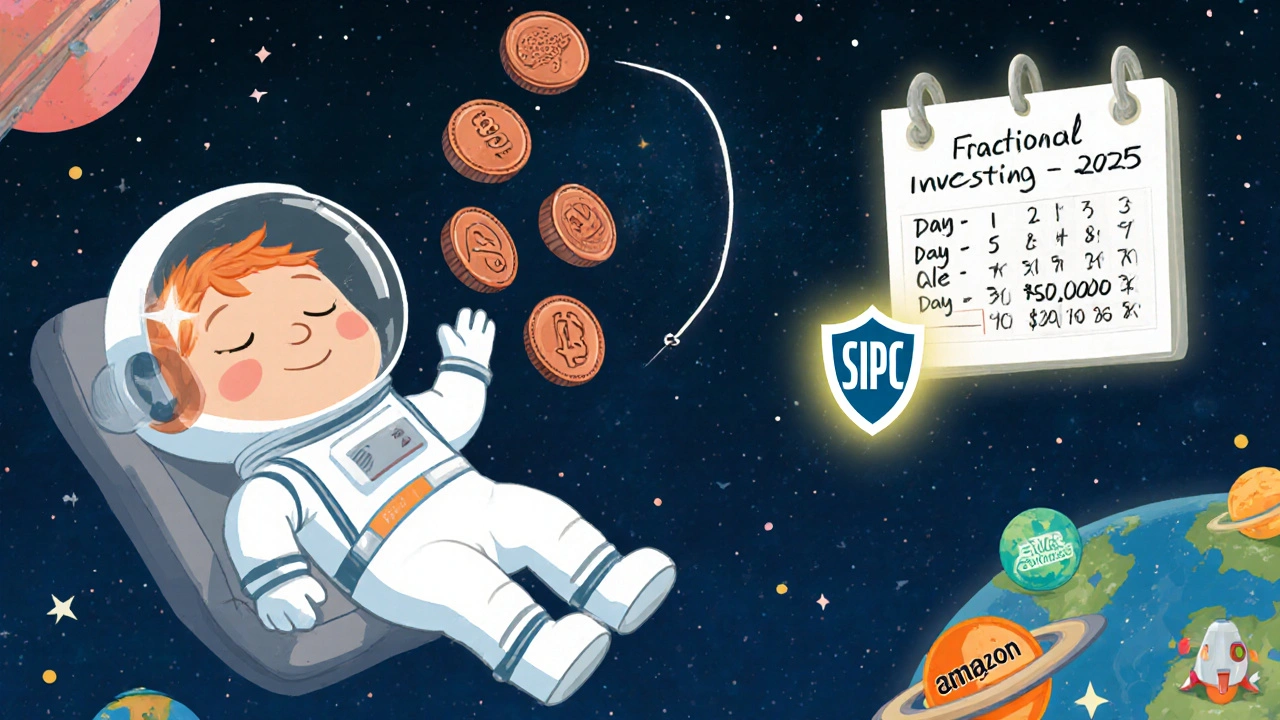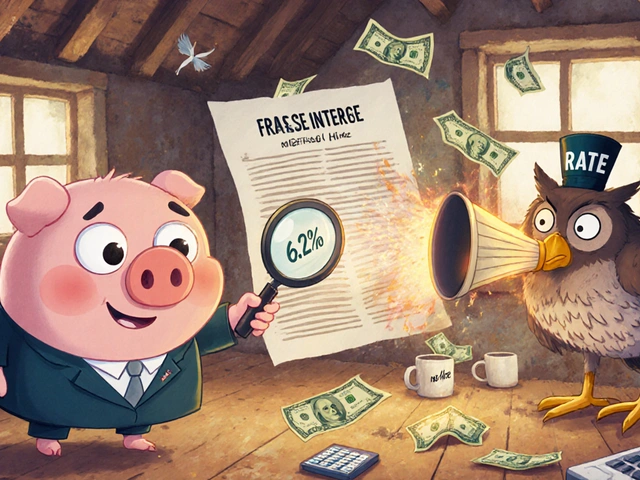Fractional Broker Selector
Find Your Perfect Fractional Broker
Why this recommendation?
Based on your preferences, this broker offers the best balance of low minimums, zero fees, and automatic dividend reinvestment to maximize your small investments.
Buying a full share of Amazon or Netflix used to mean saving up hundreds or even over a thousand dollars. Today, you can start with just $5-or even $0.01-and own a piece of those companies. That’s the power of fractional share trading. By 2025, it’s no longer a niche feature. It’s the default way millions of new investors enter the market. Whether you’re earning $35,000 a year or managing a six-figure portfolio, fractional shares let you build precision, diversify smarter, and invest consistently without waiting to save up for whole shares.
Why Fractional Shares Matter More Than Ever in 2025
It’s not just about affordability. Fractional shares give you control over your asset allocation. Want 0.02 shares of Tesla instead of 1 whole share? Done. Need to rebalance your portfolio by adding $12.50 worth of Apple? Easy. This level of granularity was impossible a decade ago.
According to J.P. Morgan, fractional trading will make up nearly 39% of all retail equity trades by 2027. That’s up from just 21% in 2024. Why? Because investors are learning that owning a little bit of many high-quality companies beats putting all your money into one expensive stock. And with dividend reinvestment now automatic on nearly every platform, even small purchases grow over time.
The biggest shift? It’s no longer just for beginners. Investors with multi-million dollar portfolios use fractional shares to fine-tune exposure-buying exactly the right amount of NVIDIA or Meta to hit their target weights. Fractional trading turned investing from a binary choice (“Can I afford this?”) into a precise tool.
Top 5 Brokers for Fractional Share Trading in 2025
Not all brokers are created equal when it comes to fractional shares. Some limit you to a handful of stocks. Others charge hidden fees. A few even restrict dividend reinvestment. Here are the five platforms that stand out in 2025 based on selection, cost, usability, and features.
1. Interactive Brokers (IBKR)
Interactive Brokers isn’t just the best for fractional shares-it’s the only one that makes them feel like a professional tool, not a gimmick.
- Selection: Over 10,500 U.S. stocks and ETFs, plus access to Canadian and European fractional shares.
- Minimum: $5 per trade.
- Fees: $0.10 clearing fee per transaction-among the lowest in the industry.
- Dividend Reinvestment: Automatic for nearly all eligible stocks and ETFs.
- Extra: Launched fractional options on 500 securities in January 2025. Also offers direct cryptocurrency trading.
It’s not the friendliest app. The interface is dense, and setup takes longer than others. But if you want the widest selection, lowest fees, and global reach, IBKR is unmatched. Trustpilot gives it a 4.1/5 rating, with users praising its depth but noting the learning curve.
2. Fidelity
Fidelity wins on simplicity and cash management. It’s the best choice for most people-especially those who want to invest small amounts regularly.
- Selection: 7,000+ U.S. stocks and ETFs.
- Minimum: $0.01. Yes, you can buy a fraction of a cent’s worth of stock.
- Fees: $0. No commissions. No clearing fees.
- Dividend Reinvestment: Automatic and free for all eligible holdings.
- Extra: Uninvested cash earns 4.85% APY. Launched recurring fractional investments with $0.01 increments in February 2025, processing over 1.2 million transactions in the first week.
Fidelity’s app is clean, reliable, and backed by decades of trust. Its 4.5/5 Trustpilot rating reflects strong customer service and ease of use. If you want to dollar-cost average into Amazon or Google every week without worrying about fees or minimums, Fidelity is your go-to.
3. Charles Schwab
Schwab is solid-but limited. It’s great if you already bank with them, but not if you’re looking for breadth.
- Selection: Only 500 stocks and ETFs eligible for fractional shares.
- Minimum: $5 per trade.
- Fees: $0 commission.
- Dividend Reinvestment: Available for eligible securities.
- Extra: Planning to expand to 2,000 fractional securities by Q3 2025. No crypto trading yet (coming in 2026).
Schwab’s interface is intuitive, and its customer service is top-tier. But with only 500 options, you’re missing out on most of the market. If you’re waiting for them to add more stocks, you might want to consider other brokers now.
4. Firstrade
Firstrade is the hidden gem for cost-focused investors who want more than just stocks.
- Selection: Over 4,000 U.S. stocks and ETFs.
- Minimum: $5 per trade.
- Fees: $0 commission on stocks, ETFs, and options.
- Dividend Reinvestment: Available.
- Extra: One of the few brokers offering commission-free fractional options trading.
It’s not flashy. The app feels outdated, and research tools are thin. But if you’re buying $5 chunks of Tesla, Netflix, and AMD every month-and also want to trade options-Firstrade gives you more freedom than most. It’s a no-frills, no-fee platform that delivers exactly what it promises.
5. Tastytrade
Tastytrade is built for active traders who like to think in terms of probabilities and risk. It’s not for passive investors-but it’s excellent for those who want to build positions slowly.
- Selection: Thousands of U.S. stocks and ETFs.
- Minimum: $5 per trade.
- Fees: $0.10 clearing fee per trade.
- Dividend Reinvestment: Available for most holdings.
- Extra: Mobile app is highly rated for speed and clarity. Strong educational content on options and income strategies.
Users on Webull and Reddit praise its app for making small investments feel intentional. If you’re learning how to trade options alongside fractional shares, Tastytrade’s tools and clarity make it a standout.

Who Should Avoid Fractional Share Trading?
Not every broker supports fractional shares-and some shouldn’t be used for them at all.
Vanguard only lets you buy fractional shares of its own mutual funds and ETFs. No Amazon. No Apple. No Tesla. If you’re looking to invest in individual stocks, Vanguard’s fractional offering is useless. Even their dividend reinvestment excludes many foreign and low-volume U.S. stocks.
Robinhood pioneered fractional shares for beginners, but its platform still lacks research tools, real-time data, and solid customer support. If you’re serious about investing, not just dabbling, Robinhood won’t grow with you.
Robo-advisors like Betterment and Wealthfront offer fractional investing, but you’re giving up control. They auto-allocate your money based on algorithms. If you want to pick specific stocks, you need a brokerage account.
What to Watch Out For
Even among the best brokers, there are traps.
- Clearing fees: IBKR and Tastytrade charge $0.10 per trade. That adds up if you’re buying $5 chunks every week. Fidelity and Schwab avoid this entirely.
- Dividend reinvestment rules: Some platforms don’t reinvest dividends on foreign stocks or low-volume ETFs. Always check the fine print.
- Minimums: Fidelity’s $0.01 minimum is rare. Most others require $5. If you’re trying to invest $1 or $2, you’re out of luck unless you use Fidelity.
- Security selection: If you want to buy fractional shares of a small-cap stock or international ETF, verify it’s available before opening an account.
Also, remember: fractional shares are still real ownership. You’re not buying a contract or a derivative. You own a proportional part of the stock. That means you get dividends, voting rights (if you own enough to trigger them), and capital gains treatment.

How to Start in 3 Minutes
Setting up fractional trading is faster than ordering coffee.
- Choose your broker based on your needs: Fidelity for simplicity, IBKR for selection, Firstrade for options.
- Open an account online. You’ll need your ID and Social Security number.
- Link your bank account. Most brokers verify this in under 24 hours.
- Go to the “Buy” or “Trade” section. Type in the stock name, then select “Fractional” or “Dollar Amount.”
- Enter your amount: $10, $25, $50. Click “Buy.” Done.
That’s it. No forms. No phone calls. No waiting weeks. You can start investing small amounts the same day your account is approved.
Future Trends: What’s Coming Next
The fractional market is still evolving.
- More stocks: Schwab plans to expand from 500 to 2,000 eligible stocks by late 2025.
- More ETFs: Vanguard is reportedly considering allowing fractional shares of non-Vanguard ETFs, pending regulatory approval.
- More automation: Recurring fractional investments are becoming standard. Fidelity’s $0.01 increments mean you can invest literally pennies per day.
- More regulation: The SEC is watching dividend mechanics closely. Expect clearer rules around how brokers handle fractional dividends by 2026.
One thing’s certain: fractional shares aren’t going away. They’re becoming the foundation of how everyday people build wealth.
Can you really own a fraction of a stock?
Yes. When you buy a fractional share, your broker holds the full share on your behalf in street name. You’re the beneficial owner of that portion. You receive proportional dividends, and if the stock splits or pays a dividend, you get your share. It’s real ownership, not a contract or ETF.
Do fractional shares pay dividends?
Yes. If the stock pays a dividend, you get a proportional amount. For example, if a stock pays $2 per share and you own 0.1 shares, you get $0.20. Most major brokers automatically reinvest these dividends at no extra cost.
Is fractional share trading safe?
Yes, if you use a regulated broker. All top platforms are SEC- and FINRA-regulated. Your fractional shares are protected under SIPC insurance up to $500,000, including $250,000 for cash. This is the same protection as whole shares. Avoid unregulated apps or platforms that don’t disclose their custodians.
Can you sell fractional shares anytime?
Yes. You can sell your fractional shares at any time during market hours, just like whole shares. The sale is processed at the current market price, and you receive the proportional amount. There’s no lock-up period or restriction.
Which broker is best for beginners?
Fidelity is the best for beginners. It has no minimums, no fees, a simple app, and excellent customer support. You can start with $0.01 and learn as you go. Robinhood is tempting, but its lack of research tools and support makes it risky for long-term growth.
Are fractional shares good for retirement accounts?
Absolutely. IRAs and 401(k)s that support fractional shares let you invest small amounts regularly without worrying about buying whole shares. Fidelity and Schwab both offer fractional investing in retirement accounts, making dollar-cost averaging easy and automatic.
If you’re still waiting to save up for a full share of a high-priced stock, you’re losing time. With fractional shares, your first $5 today could be the start of a $10,000 portfolio in five years. Start small. Stay consistent. Let compound growth do the rest.




It’s fascinating how fractional shares have quietly revolutionized the very philosophy of wealth-building-no longer is investing a game of accumulation, but one of precision. You don’t need to wait years to afford a single share; you can now sculpt your portfolio like a sculptor shaping clay, grain by grain. The psychological shift is profound: instead of ‘Can I afford this?’ it becomes ‘How much of this do I truly want?’ And with dividend reinvestment automatic, even the tiniest fraction becomes a seed that grows silently, relentlessly, over time. It’s not just democratization-it’s dignification of smallness. The market no longer demands you be rich to participate; it invites you to be consistent. And consistency, as we’ve learned from centuries of compound growth, is the quietest, most unstoppable force in finance.
Also, I find it poetic that the most powerful tool for the average person emerged not from Wall Street, but from the apps we use to order coffee. The future isn’t in big banks-it’s in the $0.01 transactions we barely notice.
Still, I wonder: will future generations look back at this era and see it as the moment when capitalism finally learned to be humane?
Bro, IBKR’s $0.10 clearing fee is a total tax on micro-investing. If you’re doing weekly $5 buys, that’s 2% deadweight loss right there-no bueno. Fidelity’s $0.01 min + zero fees is the only sane play. Schwab’s 500-stock limit is laughable in 2025. And don’t even get me started on Robinhood’s ‘investing’ app that’s basically a casino with a balance sheet. Tastytrade’s options integration is solid though-real alpha for the retail quant crowd. Also, dividend reinvestment on foreign ETFs? Still a minefield. Read the S-1s, people. This isn’t your dad’s 401(k).
Also, fractional options on 500 securities? IBKR just turned retail into a hedge fund simulator. We’re not investing anymore. We’re algorithmically arbitraging our lunch money.
Oh wow, another ‘fractional shares are the future’ think piece. How original. Let me guess-you also think ‘dollar-cost averaging’ is a revolutionary strategy and that ‘starting small’ is a moral victory. Newsflash: owning 0.003 shares of Tesla doesn’t make you an investor. It makes you a spectator with a mobile app addiction.
And Fidelity’s 4.85% APY on uninvested cash? Cute. That’s just a bait-and-switch to keep you from actually deploying capital. You think you’re being smart by investing $0.01 a day? You’re just feeding the machine. The real wealth isn’t in fractional shares-it’s in owning whole shares of cash-generating businesses, not algorithmically fragmented paper.
Also, ‘dividend reinvestment’? Please. Most brokers auto-reinvest at the closing price, which means you’re buying high and getting diluted by the very ETFs that just pumped. And don’t get me started on SIPC protection-it doesn’t cover you if the broker goes belly-up and your fractional shares get commingled in a custodial black hole. You think you’re protected? You’re just a line item in a spreadsheet.
And yet, here we are. Millions of people buying fractions of Amazon like it’s a lottery ticket. The market isn’t democratized-it’s infantilized. But hey, at least you can feel like a capitalist while scrolling TikTok. Congrats.
PS: If you’re still using Robinhood, you’re not an investor. You’re a beta tester for a gambling platform. Go get a real broker-or better yet, go read a book. You’re not ready for this.